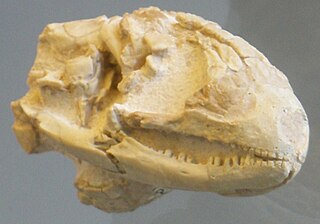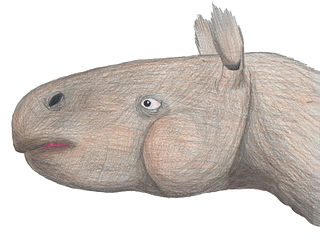
Velociraptor is a genus of dromaeosaurid theropod dinosaur that lived approximately 75 to 71 million years ago during the latter part of the Cretaceous Period. Two species are currently recognized, although others have been assigned in the past. The type species is V. mongoliensis; fossils of this species have been discovered in Mongolia. A second species, V. osmolskae, was named in 2008 for skull material from Inner Mongolia, China.

Andrewsarchus is an extinct genus of mammal that lived during the middle Eocene epoch in what is now Inner Mongolia, China. Only one species is usually recognized, A. mongoliensis, known from a single skull of great size discovered in 1923 during the expeditions to central Asia by the American Museum of Natural History (AMNH). Generally classified as a mesonychid since its original description, most recent studies classify it as an artiodactyl. One study specifically classifies Andrewsarchus as a member of the clade Cetancodontamorpha, closely related to entelodonts, hippos and cetaceans.

Sarkastodon is an extinct genus of mammal within the creodont family Oxyaenidae that lived during the early to late Eocene, 48.6 to 37.2 million years ago. It was a large, carnivorous animal that lived in what is today China and Mongolia. Sarkastodon is known only from a skull and jawbones. Sarkastodon was probably a hypercarnivore that preyed on large mammals in its range during the Late Eocene, such as brontotheres, chalicotheres, and rhinoceroses. Its weight is estimated at 800 kg (1,800 lb), and its length at 3 m (10 ft).

Saurornithoides is a genus of troodontid maniraptoran dinosaur, which lived during the Late Cretaceous period. These creatures were predators, which could run fast on their hind legs and had excellent sight and hearing. The name is derived from the Greek stems saur~ (lizard), ornith~ (bird) and eides (form), referring to its bird-like skull.

Psittacosaurus is a genus of extinct ceratopsian dinosaur from the Early Cretaceous of what is now Asia, existing between 126 and 101 million years ago. It is notable for being the most species-rich dinosaur genus. Up to 12 species are known, from across China, Mongolia, Siberia, and possibly Thailand and Laos. The species of Psittacosaurus were obligate bipeds at adulthood, with a high skull and a robust beak. One individual was found preserved with long filaments on the tail, similar to those of Tianyulong, and scales across the rest of the animal. Psittacosaurus probably had complex behaviours, based on the proportions and relative size of the brain. It may have been active for short periods of time during the day and night, and had well-developed senses of smell and vision.
Phaedrolosaurus is a genus of theropod dinosaur, based on a single tooth possibly from the Valanginian-Albian-age Lower Cretaceous Lianmugin Formation of Wuerho, Xinjiang, China.

Peltosaurus is an extinct genus of anguid lizard from North America that lived from the Eocene to the Oligocene. Peltosaurus belongs to the anguid subfamily Glyptosaurinae. The type species Peltosaurus granulosus was named in 1873 by American paleontologist Edward Drinker Cope. Many additional species have been named, but most have been reassigned to different genera. For example, Peltosaurus piger, named in 1928, was reclassified as Odaxosaurus piger, and P. jepseni, named in 1942 from the Paleocene of Wyoming, but was later reclassified as Proxestops jepseni. In 1955 a new species, Peltosaurus macrodon, was named from the Eocene of California. Lizard bones from the Late Miocene of Nebraska were attributed to a new species of Peltosaurus called P. minimus in 1976, extending the fossil range of Peltosaurus and Glyptosaurinae into the Neogene. However, these bones were later referred to a genus of skinks called Eumeces, meaning that the fossil range of Peltosaurus and Glyptosaurinae does not go beyond the Paleogene.

Gilmoreosaurus is the name given to a genus of dinosaur from the Cretaceous of Asia. The type species is Gilmoreosaurus mongoliensis. It is believed to be a hadrosaur or iguanodont from the Iren Dabasu Formation of Inner Mongolia, dating to 96 Ma ago. Additional specimens have been described as distinct species, including G. atavus from the Khodzhakul Formation of Uzbekistan and G. arkhangelskyi from the Bissekty Formation. However, these are based on very fragmentary remains, and their classification is dubious. An additional species, G. kysylkumense is sometimes included, though it has also been referred to the related genus Bactrosaurus.
Heishansaurus, meaning "Heishan lizard" after the area in China where it was discovered, is the name given to a dubious genus of herbivorous ornithischian dinosaur.

Diplomystus is an extinct genus of freshwater clupeomorph fish distantly related to modern-day extant herrings, alewives, and sardines. The genus was first named and described by Edward Drinker Cope in 1877. There are seven species of Diplomystus: D. dentatus, D. birdii, D. dubetreiti, D. shengliensis, D. kokuraensis, D. primotinus, and D. altiformis.

The Iren Dabasu Formation is a Late Cretaceous (Cenomanian) geologic formation in the Iren Nor region of Inner Mongolia. Dinosaur remains diagnostic to the genus level are among the fossils that have been recovered from the formation. The formation was first described and defined by Henry Fairfield Osborn in 1922 and it is located in the Iren Nor region of China.
The Bayan Mandahu Formation is a geological unit of "redbeds" located near the village of Bayan Mandahu in Inner Mongolia, China Asia and dates from the late Cretaceous Period. Laid down in the Campanian, it is dated somewhat uncertainly to between 75-71 mya.

Helodermoides is an extinct genus of anguid lizards from the Oligocene of North America. The genus is monotypic, including only the species Helodermoides tuberculatus. Helodermoides belongs to an extinct subfamily of anguids called Glyptosaurinae. In addition to many fragmentary bones, several complete skeletons of Helodermoides are known. Like other glyptosaurines, Helodermoides was covered in small scale-like bones called osteoderms. The osteoderms covering its skull are hexagonal, tightly interlocking, raised, and rounded.

Forstercooperia is an extinct genus of forstercooperiine paraceratheriid rhinoceros from the Middle Eocene of Asia.

This timeline of oviraptorosaur research is a chronological listing of events in the history of paleontology focused on the oviraptorosaurs, a group of beaked, bird-like theropod dinosaurs. The early history of oviraptorosaur paleontology is characterized by taxonomic confusion due to the unusual characteristics of these dinosaurs. When initially described in 1924 Oviraptor itself was thought to be a member of the Ornithomimidae, popularly known as the "ostrich" dinosaurs, because both taxa share toothless beaks. Early caenagnathid oviraptorosaur discoveries like Caenagnathus itself were also incorrectly classified at the time, having been misidentified as birds.
Deperetella is an extinct genus of herbivorous mammals that flourished in the Eocene and were related to tapirs. The genus was defined in 1925 by W. D. Matthew and Walter W. Granger, who named it after French paleontologist Charles Depéret.

Pappaceras is an extinct genus of rhinoceros from the Early Eocene of Asia belonging to Paraceratheriidae.
Paraplacosauriops is an extinct genus of anguid lizards from the middle Eocene of France.
Robert Michael "Bob" Sullivan is a vertebrate paleontologist, noted for his work on fossil lizards and dinosaurs.












